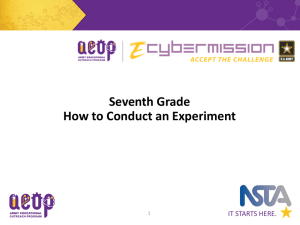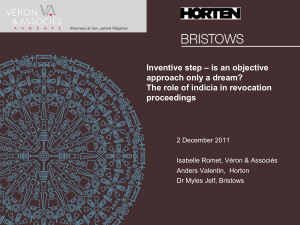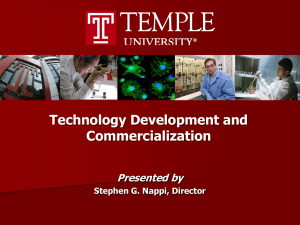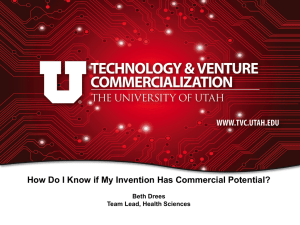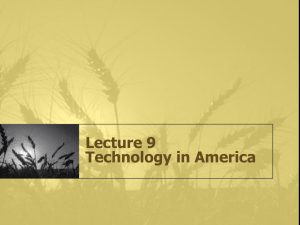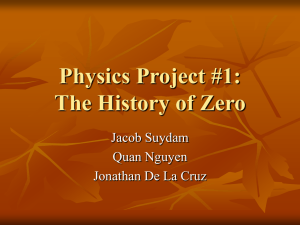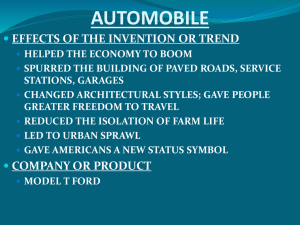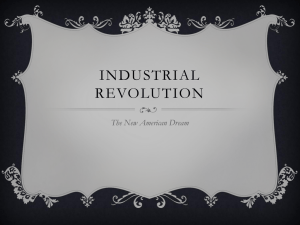Prior art
advertisement
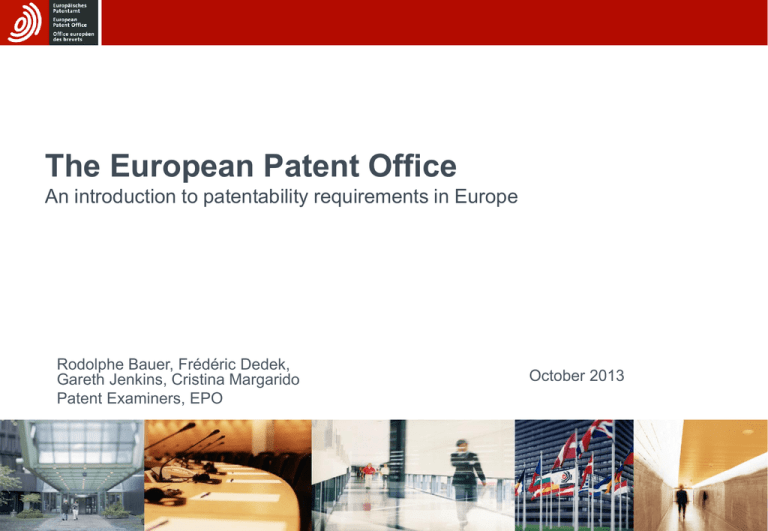
The European Patent Office An introduction to patentability requirements in Europe Rodolphe Bauer, Frédéric Dedek, Gareth Jenkins, Cristina Margarido Patent Examiners, EPO 09/04/2015 October 2013 The requirements for patentability Exclusions Exceptions Novelty Inventive Step Industrial applicability What is a patent? A patent is a legal title granting its holder the exclusive right to prevent third parties from exploiting an invention (making, using, offering for sale, selling or importing infringing products) without authorisation in a defined country and for a limited period, e.g. 20 years. In return for this protection, the holder has to disclose the invention to the public. Reveal invention Get exclusivity Patent requirements An application contains – Bibliographic information Inventor, proprietor, date of filing, technology class, etc. – Description Summary of prior art (i.e. the known existing technology) The problem that the invention is supposed to solve An explanation and at least one way of carrying out the invention – Claims Define the extent of patent protection – Drawings Illustrate the claims and description – Abstract Around 150 words as a search aid for other patent applications Article 52 Patentable inventions (1) European patents shall be granted for any inventions, in all fields of technology, ... (2) The following in particular shall not be regarded as inventions within the meaning of paragraph 1: – (a) discoveries, scientific theories and mathematical methods; – (b) aesthetic creations; – (c) schemes, rules and methods for performing mental acts, playing games or doing business, and programs for computers; – (d) presentations of information. (3) Paragraph 2 shall exclude the patentability of the subject-matter or activities referred to therein only to the extent to which a European patent application or European patent relates to such subject-matter or activities as such. Article 52 EPC Article 53 Exceptions to patentability European patents shall not be granted in respect of: a) Inventions the commercial exploitation of which would be contrary to “ordre public” or morality; such exploitation shall not be deemed to be so contrary merely because it is prohibited by law or regulation in some or all of the Contracting States; b) Plant or animal varieties or essentially biological processes for the production of plants or animals; this provision shall not apply to microbiological processes or the products thereof; c) Methods for treatment of the human or animal body by surgery or therapy and diagnostic methods practiced on the human or animal body; this provision shall not apply to products, in particular substances or compositions, for use in any of these methods. The requirements for patentability Exclusions Exceptions Novelty Inventive Step Industrial applicability Art. 52(1) European patents shall be granted for any inventions, in all fields of technology, provided that they are new, involve an inventive step and are susceptible of industrial application Novelty Why do we search & examine for novelty? An electric light bulb as has been used for decades A patent application filed yesterday Would you grant a patent for something which is already known? What does "new" mean? Already known Already known Patent application Novelty "(1) An invention shall be considered to be new if it does not form part of the state of the art." (2) The state of the art shall be held to comprise everything made available to the public by means of a written or oral description, by use, or in any other way, before the date of filing of the European patent application. (3) .... (4) .... (5) .... Article 54 EPC What is the "state of the art"? Everything made available to the public by means of ... ... before the filing date of the application written description oral description State of the art or in any other way by use Article 54(2) EPC Which disclosures can we use? Filing date 01.09.2010 2006 2007 2008 2009 2010 2011 2012 time Priority date 01.09.2009 Everything made available to the public before the date of filing (priority) Article 54 EPC Novelty Test: Feature Analysis Novelty Novelty : featureTest: analysis Feature Novelty Test: Feature Analysis Analysis 1. Personal computer Claim: 1. 2. 3. 4. 5. 6. PersonalClaim: computer + a screen + a2. screen Claim: + a keyboard 3. + a keyboard 1. Personal computer + a key 1. 2. Personal computer + a screen 4. + a key + ... 2. 3. + a+ screen a keyboard + ... 3. 5. + a++ keyboard 4. a ... key 4. 5. + a+ key 6. +...... 5. 6. + ... + ... 6. + ... prior art prior art prior art Novelty test A device for watering plants having a watercontaining portion (1), a handle (2), an opening with a lid (3) and a spout (4)*. B F A C *A projecting pipe or tube, e.g. as in a teapot. E D up Implicit features/interpretation of "... for ..." Claim: "A half-circle-shaped hook for a crane, made of stainless steel, the edge of the hook pointing upwards when the hook is hung up" Intended Prior art: "A stainless steel hook for fishing, in the shape of a half-circle, pointing upwards when hung up" Claim: a stainles in the sh pointing Combination of documents Can we use a combination of documents to attack novelty? Novelty: Equivalents (1) Claim Prior art A watering can of aluminium A watering can of zinc NEW Novelty: Equivalents (2) A watering can made of zinc (prior art) is NOT IDENTICAL to a watering can made of aluminium (claim) THE SUBJECT-MATTER OF THE CLAIM IS NEW Generic disclosures vs. specific examples Claim A watering can made of metal Prior art A watering can made of aluminium NEW Generic disclosures vs. specific examples (2) Claim A watering can made of metal Prior art A watering can made of aluminium Does the prior art disclose "a watering can made of metal"? Yes! Why? Because aluminium is a metal. THE SUBJECT-MATTER OF THE CLAIM IS NOT NEW The requirements for patentability Exclusions Exceptions Novelty Inventive Step Industrial applicability Art. 52(1) European patents shall be granted for any inventions, in all fields of technology, provided that they are new, involve an inventive step and are susceptible of industrial application Inventive step "An invention shall be considered as involving an inventive step if, having regard to the state of the art, it is not obvious to a person skilled in the art." Article 56 EPC The person skilled in the art is a skilled practitioner in the relevant field has access to everything in the state of the art is possessed of average knowledge and ability is aware of what is common general knowledge in a particular technical field at the relevant date has a normal capacity for routine work, but no inventive skills is involved in constant development in his field is expected to look for suggestions in neighbouring and general technical fields or even remote technical fields may in some fields be a team rather than an individual person has the same level of skill for assessing inventive step and sufficiency of disclosure If the problem prompts the skilled person to seek its solution in another technical field, the specialist in that other field is the person qualified to solve the problem. How do we decide on obviousness? Various tests in different national systems One of the tests used by the German Patent Office is that every invention is a solution to a problem. In the very first case heard by the EPO boards of appeal, the problem/solution approach was used to decide on the question of inventive step. The problem/solution approach 1. Determine the closest prior art This is the item of prior art disclosing the technical effects, purpose or intended use most similar to the invention. It often has the greatest number of features in common with the invention. 2. Based on this, establish the objective technical problem to be solved. How to modify or adapt the closest prior art to achieve the technical effects of the invention 3. Consider whether the claimed invention, starting from the closest prior art and the objective technical problem, would have been obvious to a skilled person. Is there an indication in a document of the prior art that would prompt the skilled person to solve the (objective) technical problem by modifying or adapting the closest prior art to arrive at the claimed invention? EPO Guidelines G-VII, 5 The problem/solution approach ̶ five questions 1.What is the closest prior art ? 2.What is the difference, in terms of the claimed technical features, between the claimed invention and the closest prior art ? 3.What technical effect is caused by this difference ? 4. What, therefore, is the objective technical problem underlying the claimed invention? 5.Would the skilled person solve this problem in the manner indicated on the basis of the totality of the prior art, without at any stage employing any inventive skill ? Question 1: What is the closest prior art? (1/3) The closest prior art is normally the structurally closest prior art, provided that it: belongs to the same or closely related technical field has a similar purpose or effect as the invention constitutes the most promising starting point for an obvious development leading to the invention corresponds to similar use and requires the minimum of structural and functional modifications B F E E A C D Question 2: What is the difference, in terms of the claimed technical features, between the invention and the closest prior art? Identify all those features which render the claimed subject-matter of the claim novel in view of the closest prior art only. B F E E A C D Question 3: What technical effect is caused by this difference? Review the difference between the claimed invention and the closest prior art. Determine which technical effect the invention achieves due to these differences. There may be no technical effect over the prior art! Question 4: What, therefore, is the objective technical problem underlying the claimed invention? Subjective problem vs. objective problem Don't include elements of the claimed solution in the objective problem If the closest prior art does not provide all the effects of the invention that relate to the distinguishing technical features, then the problem is "how to modify or adapt the closest prior art to achieve the technical effects which the invention provides over the closest prior art." Question 5: Would the skilled person solve this problem on the basis of the totality of the prior art without employing any inventive skill? "would" vs. "could" combination of two prior art documents normally used Question 5: Would the skilled person solve this problem on the basis of the totality of the prior art without employing any inventive skill? IF the prior art (including the closest) does not provide an indication that would prompt the skilled person to solve the problem in the way that the inventor solves it THEN the invention is not obvious vs. The requirements for patentability Exclusions Exceptions Novelty Inventive Step Industrial applicability Art. 52(1) European patents shall be granted for any inventions, in all fields of technology, provided that they are new, involve an inventive step and are susceptible of industrial application Need more information? Visit www.epo.org Contact us at www.epo.org/contact Follow us on www.facebook.com/europeanpatentoffice twitter.com/EPOorg www.youtube.com/EPOfilms www.linkedin.com/company/european-patentoffice Thank you for your attention.
